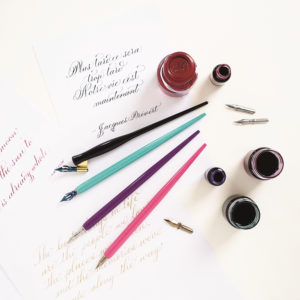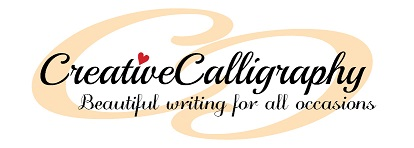A bad workman blames his tools, as the saying goes.
But when it comes to calligraphy, the idiom doesn’t always ring true.
Success in calligraphy is often dependent on the quality of the equipment you’re using, so it’s worth doing your research on nibs, inks, pen holders – and paper.

Danielle Stanley, from Under the Rowan Trees.
Paper is something I get asked about a lot at workshops, particularly when people start experimenting with different materials.
The process of working out the right combination of paper, pen and ink can be fun, but also a source of frustration for the budding calligrapher.
So, before you decide to down tools completely, here are some paper tips from stationer Danielle Stanley, at Under the Rowan Trees.
Am I using the right paper?
After investing in beautiful pens, brushes and nibs, you want to make them last and for them to perform beautifully every time you pick them up.
Using cheap copier paper is good for your bank balance, but not great for your tools. If you want to get the best results, you need the right paper for the job.
Brush pens will fray if you use rough paper and watercolours will soak through thin paper and cause it to curl. Nothing is more frustrating than pouring your heart out onto the page and for it to end up a soggy mess.
Watercolour paper
Watercolour paper is specially made to cope with (you guessed it) water. There is a huge array out there and you will need to consider:
 the quality
the quality- production method
- content
- weight
- texture
- tinting/bleaching
- form (sheets, block, pad, board)
- acid-free
- archival quality
- your budget
Standard printer paper will become soggy very quickly and disintegrate. In general, our budget dictates which watercolour papers we choose until we find a favourite.
I currently stock Van Gogh watercolour paper which is 300gsm and cold-pressed giving it a lovely texture for the pigment to grab onto. It is also available in black, which is stunning with metallic watercolours.
If you’re looking for something smoother for use with your brush pens, Ecoline paper has been specially designed to work with the vivid colours of the pens and liquid watercolours.
It is also available in a printer-friendly version, so you can use your brush pens to enhance your digital artwork.
Using a dip pen?
 When working with brush pens or dip pens, you need exceptionally smooth paper to avoid damaging the brush tips and nibs. It will also allow your ink to flow.
When working with brush pens or dip pens, you need exceptionally smooth paper to avoid damaging the brush tips and nibs. It will also allow your ink to flow.
When working on lettering drills (practising the shapes that make up the letters), I like to use a pad with dots or squares to help guide my letter formation. My favourite is the iconic Rhodia range produced by Clairefontaine in France.
Rhodia is extra-white and ultrasmooth; ideal for use with delicate tools. As it is 80gsm, there will be ghosting (able to see your work through to the other side) but only the juiciest pens should cause bleeding (ink leaking through to the other side of the paper).
Want to combine your love of lettering with your love of journaling?
For watercolours and markers, I recommend Archer and Olive journals as the 160gsm is almost bomb proof. I’ve yet to find a pen or paint that causes ghosting or bleeding.
If you are a fan of fountain pens and beautiful inks, the ultra smooth Rhodia Goalbook is the one for you.
Other calligraphy tools
Curious about nibs? Check out this post.
How about cartridge pens? Read this post.
And there’s more about my favourite calligraphy tools here.



